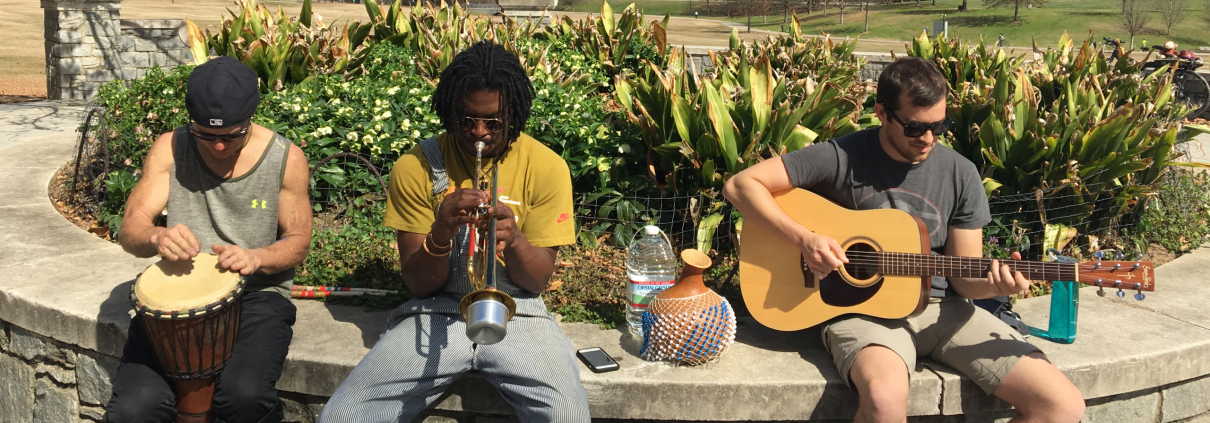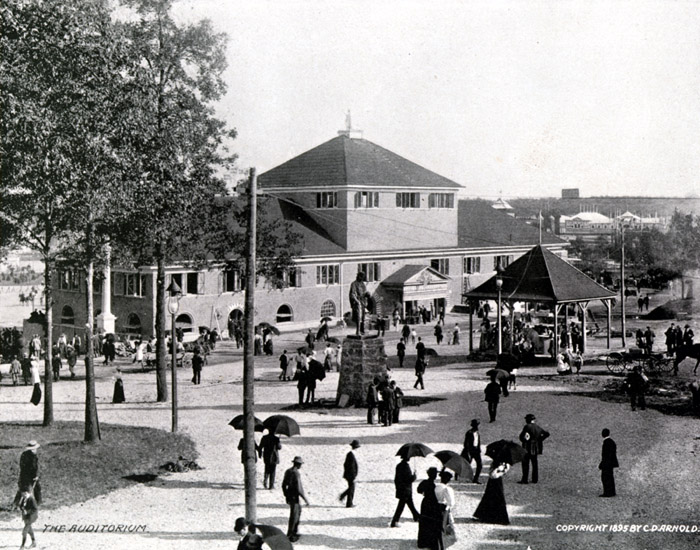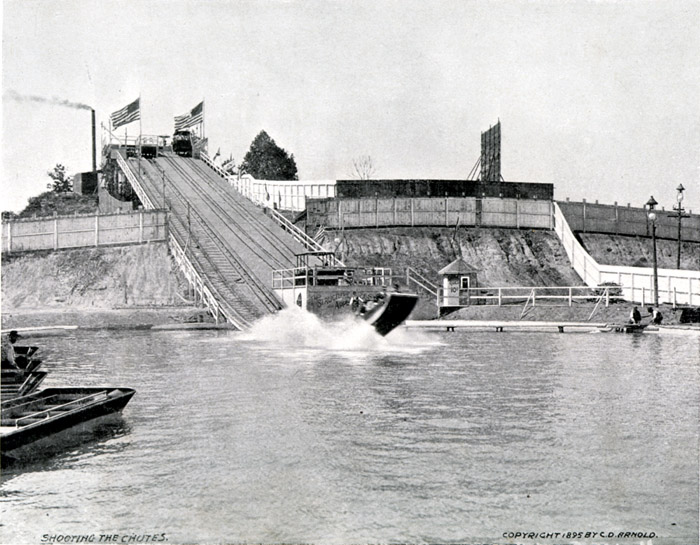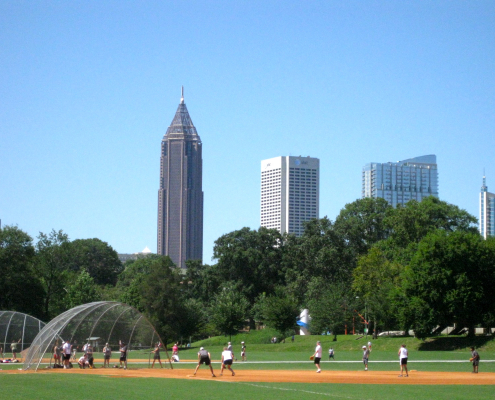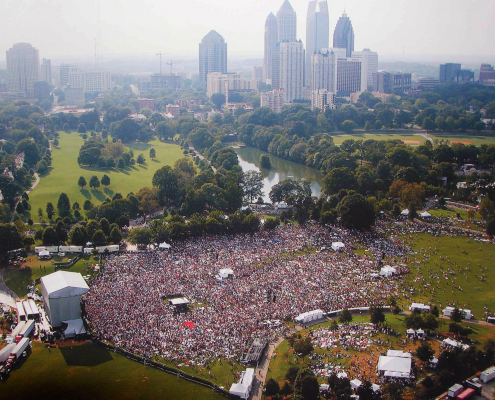A Community Space for Atlanta, A Historical Perspective
“During my childhood in the seventies, Piedmont Park was one big everlasting festival. There was the old swimming pool and bathhouse where my brother Bird and I swam in the summer, diving off the platforms and slipping down the giant slides into the water. It was where we learned to play.”
This quote from longtime Atlanta resident and novelist Celestine Sibley reflects many visitors’ experiences at Piedmont Park. Some know the Park as a place to exercise and play, while others think of it as the home of many outdoor events and festivals.
Piedmont Park was first used as a gathering place for an Atlanta Civic group, The Gentlemen’s Driving Club. The club purchased the 189-acre Walker family farm in 1887. They were looking for a place outside of the city (Atlanta was about 3 miles to the South) where they could congregate and exercise their horses. The group of prominent businessmen (including Charles Collier and Henry W. Grady) also wanted to use the space to host expositions to promote the prosperity of the Piedmont region of The United States. To that end, they formed the Piedmont Exposition Company, which held their first exposition at The Gentlemen’s Driving Club later that same year.
There were 20,000 visitors to The Piedmont Exposition on opening day, October 10, 1887 and over 50,000 people attended on October 18th to see President Grover Cleveland. Also, in attendance was the Executive Committee of the World’s Fair organization. They were on hand to determine if Atlanta was ready to host a World’s Fair. The event closed on October 22 with a total attendance of about 200,000. When the exposition was over, civic leaders said that it had successfully expanded Atlanta’s reputation as a place to visit and to conduct business. The site, formerly known as “The Walker Farm,” had an official name change to “Piedmont Park.”
Piedmont Park was soon to host yet another impressive fair. The Cotton States and International Exposition’s goals were to foster trade between southern states and South American nations as well as to show the products and facilities of the region to the rest of the nation and to Europe. Approximately 800,000 attended the three-month exposition which ended on December 31, 1895.
Photo Credit: Atlanta History Center
Events and exhibits at the Cotton States and International Exposition included: a performance of “King Cotton March” conducted by John Phillip Sousa, Buffalo Bill’s Wild West Show, the Liberty Bell, The Streets of Cairo, The Women’s Building, and The Negro Building. The very popular “Shoot the Chute” ride (a waterslide with boat-cars) was later moved to Lakewood Park. The Exposition even included the first ever showing of a projected motion picture which used a projector called a Phantoscope, the patent of which was later sold to Thomas Edison.
Photo Credit: Atlanta History Center
Piedmont Park has always been a popular place for sports. Georgia’s first intercollegiate sporting event was held in the Park on February 20, 1892. The University of Georgia (UGA) and the Agricultural and Mechanical College of Alabama (now known as Auburn) met head-to-head for the very first time. Nearly 125,000 swimmers swam in lake Clara Meer every year from 1911 until 1960. Atlanta’s first professional team, The Atlanta Crackers played their first baseball game against Nashville on Saturday, April 26, 1902 before a crowd of around 3,500. The Park was also home to Atlanta’s first golf course.
Atlanta’s largest urban park is also “the place” for intramural sporting events. In 2016 alone, the Active Oval (containing a running track, two soccer fields, two softball fields and two sand volleyball courts) had over 68,000 reserved players on its fields. The Park is also home to The Sharon E. Lester Tennis Center, a fully staffed, public facility, offering play on 12 lighted hard courts as well as bocce and basketball courts.
Nothing brings people together like live music and Piedmont Park has hosted some of music’s biggest stars, including The Grateful Dead (1969), R.E.M. (1982), The Black Crowes (1992), Dave Matthews Band (2007), Paul McCartney (2009), The Eagles (2010), Pearl Jam (2012), Journey (2013), and Elton John (2015).
The Atlanta Jazz Festival has been bringing thousands of visitors to Piedmont Park since it was founded by Mayor Maynard Jackson in 1978. Some of the artists that have participated in the Festival include Lionel Hampton (1980), Miles Davis (1983), Etta James (1986), Dizzy Gillespie (1988/1990), Wynton Marsalis (1989), Nina Simone (2000), Ray Charles (2002), Herbie Hancock (2000) and Macy Gray (2017).
In 2019, about a third of Piedmont Park’s 6 million visitors were attendees of special events or festivals. While these large events bring the world to Atlanta’s “Front Lawn,” it is the smaller events and family gatherings, like family reunions, birthday parties, and weddings, that truly make Piedmont Park our favorite gathering place.
Author: Patrick Teague, Piedmont Park Conservancy Docent
Sources:
- https://atlantafestivals.com/
- https://www.concertarchives.
org/ - Jim Tillman’s Tour Script
- Piedmont Park: Celebrating Atlanta’s Common Ground Hardcover – October 1, 2003
by Darlene Roth (Editor), Jeff Kemph (Editor), Lee May (Foreword)

